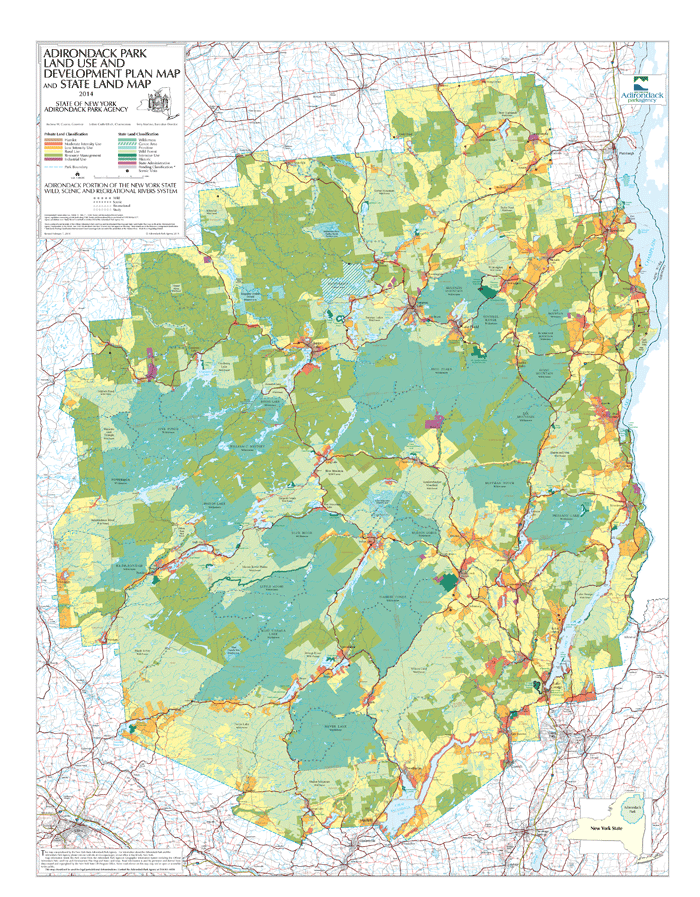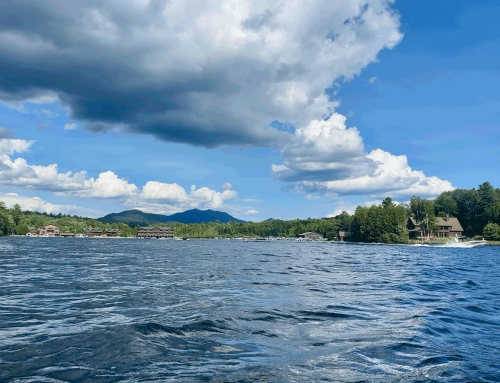Public comments needed on revision of the Adirondack Park State Land Master Plan
The Adirondack Park Agency (APA) is conducting a public hearing to gather input and ideas from stakeholders about policy revisions to the Adirondack Park State Land Master Plan (SLMP).
Click here for a copy of the State Land Master Plan.
In December 2013, as part of its classification of the Essex Chain Lakes Primitive area and other Forest Preserve lands, the APA committed to examine two SLMP revision issues: 1) the requirement for natural materials for bridges in the Forest Preserve, which impacts the creation of a possible new bridge over the Cedar River and the retention of the Polaris Bridge over the Hudson River; 2) use of mountainbikes in Primitive Areas as mountainbiking currently is only allowed in Wild Forest areas.

The map above shows Forest Preserve State Land Master Plan classifications and the various APA private land regulatory classifications.
The APA will use the public hearing, based largely as a series of listening sessions,” to gather public input on these issues as well as any other issues regarding the SLMP.
Each time the APA classifies new Forest Preserve lands it technically revises the SLMP. The APA most recently made formal classifications of Forest Preserve lands in 2013. The APA has classified new Forest Preserve lands six times since 2000. Yet, there have been no policy changes to the SLMP for more than 25 years, since the 1987 SLMP revision. The SLMP was adopted in 1972 and revised with policy changes in 1979. Since 1972, there have been just two policy revisions to the SLMP.
Natural Resource Protection is the Guiding Principle of the State Land Master Plan
The Adirondack Park State Land Master Plan (SLMP) states that if there is a “unifying theme” to management of the Forest Preserve “it is that the protection and preservation of the natural resources of the state lands within the Park must be paramount. Human use and enjoyment of those lands should be permitted and encouraged, so long as the resources in their physical and biological context as well as their social or psychological aspects are not degraded.”
The great value of the Forest Preserve has always been natural resource protection on a big scale across a large, intact landscape. This provides wild animals and wild nature an opportunity to exist in a mostly natural state without serious interference by people. Indeed, natural resource protection is what the Forest Preserve is all about. That the State of New York has set aside around 10% of the state in the “forever wild” Forest Preserve in the Adirondacks and Catskills is a great achievement.
The Forest Preserve also provides a stunning array of outdoor recreational opportunities. These opportunities are timeless, allowing people to visit places again and again with only the most subtle of changes in a world otherwise driven by ceaseless and dramatic change.
The SLMP sets out two tests for management of the Forest Preserve – natural resource protection and human use and enjoyment. Forest Preserve planning from Wilderness through Intensive Use area classifications is designed to protect natural resources while providing a broad array of public recreational options and experiences. The chief thing that separates Wilderness from less stringent classifications, such as Wild Forest, is the use of motor vehicles. Wilderness areas are supposed to be motor-free.
There is intense interest in policy revisions for the SLMP. There have been no policy changes to the SLMP for more than 25 years and many are clamoring for major changes. On balance the SLMP has successfully enacted a very durable and effective management for the Forest Preserve. Yet, many are clamoring for truly frightening changes to the SLMP to expand the use of motor vehicles in the Forest Preserve and widen trails for snowmobiles and large groomers, among other activities.
Ways to Strengthen the State Land Master Plan
Prohibition of ATVs and Similar Off-Road Vehicles in the Forest Preserve: The use of All Terrain Vehicles (ATVs) on the roads and trails through illegal public recreational use, by inholders who have been allowed to use them for ingress and egress, and by the DEC for search and rescue efforts has caused extensive damage to the Forest Preserve. The SLMP currently lists “all terrain vehicles” as a type of motor vehicle in its definition of “motor vehicles.”
Currently, no official rules, regulations or state policy prohibits ATVs from use on the Forest Preserve. The damage that these machines cause has been well documented.
The SLMP should be revised to specifically prohibit the use of ATVs in the Forest Preserve by the general public. They should only be allowed during emergency situations.
Rules and Regulations: The APA has steadfastly refused to draft official Rules and Regulations for the SLMP. This has led to numerous management failures with differences in interpretation between state agencies or differences in interpretation over time by various administrations of the APA. The APA and DEC have sought to fill the absence of official rules and regulations by drafting numerous policies, management guidance and a memorandum of understanding. Management of the Forest Preserve, and administration of the SLMP, would be vastly improved by promulgation and codification of official rules and regulations. The APA Rules & Regulations currently has a blank section 585 reserved for rules for the SLMP. The APA should set out to draft these rules.
Enforcement of Forest Preserve Violations: There is currently no satisfactory mechanism to resolves violations of the SLMP. Such failures include the existence of the Crane Pond Road in the Pharaoh Lake Wilderness, the South Meadow Road in the High Peaks Wilderness, and the West River Road in the Silver Lake Wilderness Area. The SLMP should be amended to include a section that enumerates a public process for reports about violations of the SLMP and various Unit Management Plans (UMPs). This process should detail the way in which these reports are adjudicated.
A new Forest Preserve Violations chapter should be added in the Introduction section.
State Conservation Easements Land Management: The SLMP clearly contemplated a time when state purchase of conservation easement would become a major environmental protection tool, would be widely used and amass a significant land base in the Adirondack Park. The possibility of purchase of state conservation easements in mentioned throughout the Acquisition Policy Recommendations section.
The Forest Preserve has benefitted from the 2-tiered management by the APA and DEC. This checks-and-balances system provides ample opportunities for public oversight, as each agency is required to hold public hearings in its formal actions. Furthermore, APA deliberations and decisions on major Forest Preserve issues are undertaken in a public forum, though DEC decision-making is done behind closed doors.
In comparison, conservation easement lands enjoy no such checks-and-balances between state agencies and there is far less opportunity for public oversight and involvement. Currently,management over state-held conservation easements is unilaterally controlled by the DEC. There is no public deliberation and decision making for major issues.
The APA Act does not distinguish between Forest Preserve and conservation easement lands. The APA Act directs the APA to manage all state lands. Section 816 of the APA Act states:
The department of environmental conservation is hereby authorized and directed to develop, in consultation with the agency, individual management plans for units of land classified in the master plan for management of state lands heretofore prepared by the agency in consultation with the department of environmental conservation and approved by the governor. Such management plans shall conform to the general guidelines and criteria set forth in the master plan. Until amended, the master plan for management of state lands and the individual management plans shall guide the development and management of state lands in the Adirondack Park.
2. The master plan and the individual management plans shall be reviewed periodically and may be amended from time to time, and when so amended shall as amended henceforth guide the development and management of state lands in the Adirondack park. Amendments to the master plan shall be prepared by the agency, in consultation with the department of environmental conservation, and submitted after public hearing to the governor for his approval.
3. The agency and department are hereby authorized to develop rules and regulation necessary, convenient or desirable to effectuate the purposes of this section.
Protect the Adirondacks calls on the APA to add management of state conservation easements in the SLMP. A new SLMP chapter for state held conservation easement lands would be needed in the “Introductions” section as well as in “Classifications and Guidelines” and in “Area Descriptions and Delineations.” This action would vastly improve the management of over 750,000 acres of land in the Adirondack Park. Once state held conservation easements are codified in the SLMP, easements should be added to the APA Land Use and Development Plan map.
This is an initial list.
Write a Public Comment Today to the Adirondack Park Agency
Letters must be received at the APA office by December 5, 2014:
Deputy Director, Planning Kathy Regan
PO Box 99
Ray Brook, NY 12977
Or via fax at 518-891-3938
Or via email at SLMP_Comments@apa.ny.gov
Thank you for taking a stand to defend and protect the great open space resources of the Adirondack Park.





